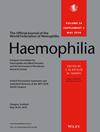Effects of physical therapy on health-related quality of life in patients with haemophilia: A systematic review and meta-analysis
Abstract
Introduction
Physical therapy benefits patients with haemophilia (PWH), but its impact on the health-related quality of life (HRQOL) remains unclear.
Aim
This systematic review and meta-analysis investigated the association of physical therapy, including therapeutic exercise, manual therapy, and physical agent modality, with HRQOL improvement in PWH.
Methods
Databases PubMed, Embase, MEDLINE, and Scopus were searched from inception until April 2024. This review included randomised controlled trials (RCTs) that compare the HRQOL between the physical therapy and control groups. Relevant data and outcome values of included study were collected. Cochrane collaboration's tool and the grading of recommendations, assessment, development, and evaluation approach were used for risk of bias (ROB) and evidence-level assessment, individually.
Results
The systematic review included eight RCTs that involved 298 male PWH. The meta-analysis for HRQOL improvement revealed a significant difference in favour of physical therapy (standardised mean difference [SMD] = .92; 95% confidence interval [CI]:.50–1.33; p < .001). Therapeutic exercise exhibited more benefits in HRQOL improvement than the control groups (SMD = 1.02; 95% CI:.49–1.55; p < .001). Physical therapy effectively improved HRQOL in PWH with better joint status (SMD = 1.74; 95% CI:.97–2.51; p < .001). Of the eight RCTs, six were rated as high ROB. The comparisons revealed a moderate certainty of evidence.
Conclusions
Physical therapy, especially therapeutic exercise, effectively improved the HRQOL of PWH. Maintaining better joint status and timely physical therapy intervention is crucial for HRQOL improvements in PWH. Cautious interpretation is required due to evidence limitations.

 求助内容:
求助内容: 应助结果提醒方式:
应助结果提醒方式:


